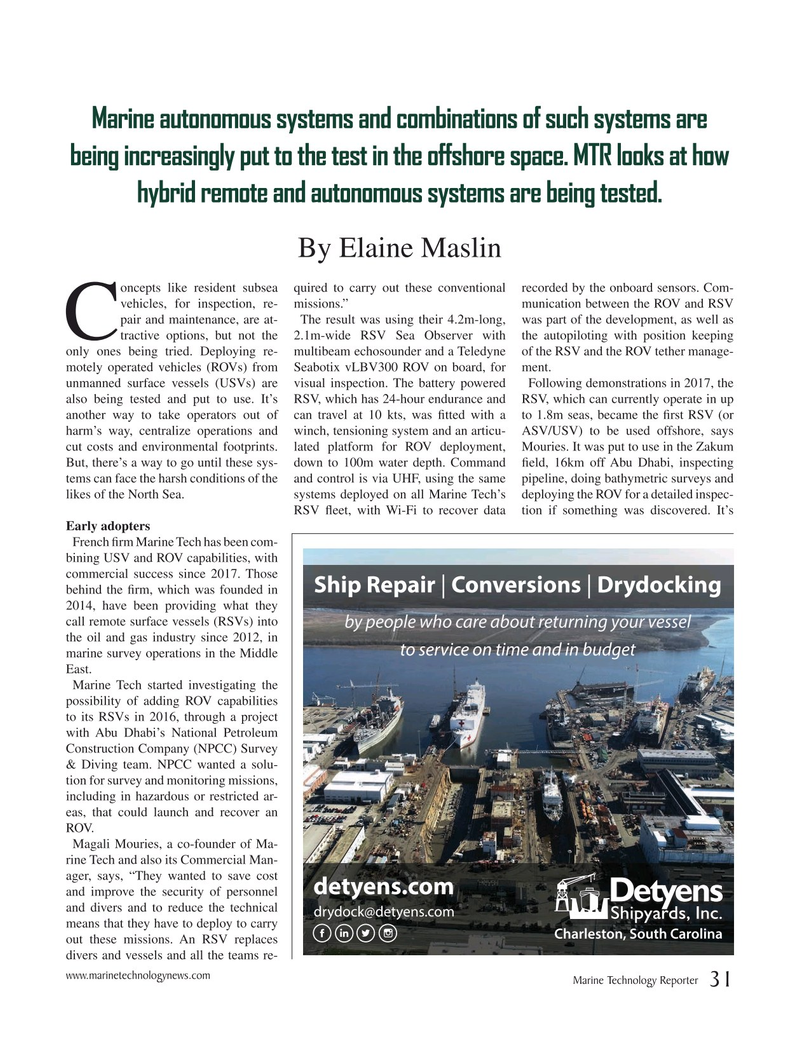
Page 31: of Marine Technology Magazine (January 2020)
Read this page in Pdf, Flash or Html5 edition of January 2020 Marine Technology Magazine
Marine autonomous systems and combinations of such systems are being increasingly put to the test in the offshore space. MTR looks at how hybrid remote and autonomous systems are being tested.
By Elaine Maslin oncepts like resident subsea quired to carry out these conventional recorded by the onboard sensors. Com- vehicles, for inspection, re- missions.” munication between the ROV and RSV pair and maintenance, are at- The result was using their 4.2m-long, was part of the development, as well as
Ctractive options, but not the 2.1m-wide RSV Sea Observer with the autopiloting with position keeping only ones being tried. Deploying re- multibeam echosounder and a Teledyne of the RSV and the ROV tether manage- motely operated vehicles (ROVs) from Seabotix vLBV300 ROV on board, for ment. unmanned surface vessels (USVs) are visual inspection. The battery powered Following demonstrations in 2017, the also being tested and put to use. It’s RSV, which has 24-hour endurance and RSV, which can currently operate in up another way to take operators out of can travel at 10 kts, was ? tted with a to 1.8m seas, became the ? rst RSV (or harm’s way, centralize operations and winch, tensioning system and an articu- ASV/USV) to be used offshore, says cut costs and environmental footprints. lated platform for ROV deployment, Mouries. It was put to use in the Zakum
But, there’s a way to go until these sys- down to 100m water depth. Command ? eld, 16km off Abu Dhabi, inspecting tems can face the harsh conditions of the and control is via UHF, using the same pipeline, doing bathymetric surveys and likes of the North Sea. systems deployed on all Marine Tech’s deploying the ROV for a detailed inspec-
RSV ? eet, with Wi-Fi to recover data tion if something was discovered. It’s
Early adopters
French ? rm Marine Tech has been com- bining USV and ROV capabilities, with commercial success since 2017. Those
Ship Repair | Conversions | Drydocking behind the ? rm, which was founded in 2014, have been providing what they call remote surface vessels (RSVs) into by people who care about returning your vessel by people who care about returning your vessel the oil and gas industry since 2012, in to service on time and in budgetto service on time and in budget marine survey operations in the Middle
East.
Marine Tech started investigating the possibility of adding ROV capabilities to its RSVs in 2016, through a project with Abu Dhabi’s National Petroleum
Construction Company (NPCC) Survey & Diving team. NPCC wanted a solu- tion for survey and monitoring missions, including in hazardous or restricted ar- eas, that could launch and recover an
ROV.
Magali Mouries, a co-founder of Ma- rine Tech and also its Commercial Man- ager, says, “They wanted to save cost detyens.com and improve the security of personnel and divers and to reduce the technical [email protected] means that they have to deploy to carry
Charleston, South Carolina out these missions. An RSV replaces divers and vessels and all the teams re- www.marinetechnologynews.com
Marine Technology Reporter 31
MTR #1 (18-33).indd 31 1/16/2020 11:32:10 AM

 30
30

 32
32
